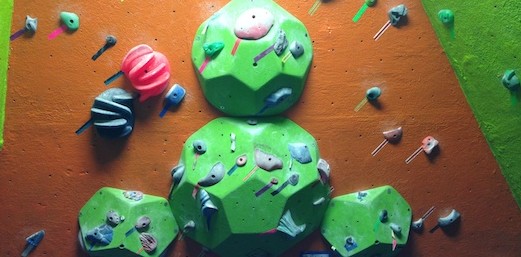
America’s indoor climbing industry is less than three decades old, but in that short span of time much has changed. CBJ is taking a look back at how the art, craft and business of making climbing holds has changed from a fringe occupation to a viable and profitable business model that has tracked the rising success of indoor climbing gyms.
While not comprehensive, here are but a few of the most important milestones in hold history:
THE BIRTH OF PLASTIC
The first artificial climbing holds were made by the French wall builder Entre Prises in 1983, but not long after that Metolius was the first to bring artificial climbing holds to the US. Metolius co-owner Brooke Sandahl recalls in The Climbing Dictionary, “We would shape in clay, let the clay master harden, and then paint the whole hold in resin.” A few other companies tried making holds by carving natural rock or by shaping and firing clay. Most of these designs were painful but climbers had few other choices. Eventually most companies began shaping with foam and making molds that would be cast with polyester resin.
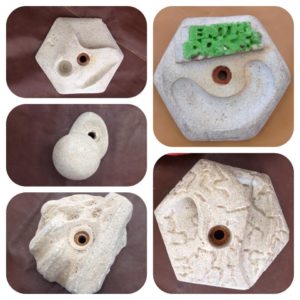
Polyester resin is relatively inexpensive, easy to cast, and provides a nice texture that climbers love. But it does have significant disadvantages. Even though companies improved their polyester resin formulas over time, they were all somewhat brittle and subject to chipping and breaking. The material is also rather heavy, and polyester resin vapors are highly toxic, presenting a hazard for hold manufacturers.
Almost a decade later, the industry was introduced to polyurethane. In the US, Groperz first used polyurethane in 1991. A bit later in 1998, according to Ian Powell, who was working for eGrips at the time, both he and Flagstaff, Arizona-based VooDoo independently began experimenting with different blends of polyurethane to produce a nearly unbreakable hold. Since the 90s nearly all climbing hold manufacturers have made the switch to polyurethane, which is extremely durable, has a superior strength to weight ratio and has enough flexibility to allow it to be bolted onto all types of walls, especially curved and highly featured walls, without breaking.
THE 3/8TH BOLT
A gym looking to place an order of new holds has thousands of options, but one thing in common with every hold they could purchase is how it will be attached to the wall. When climbing walls first started, however, there was no such standardization. The first walls featured molded wall panels with integrated holds, and later many walls had round inset panels with a hold feature that could be interchanged to create new routes. Today all holds sold in North America come with a preformed bolt-hole and washer that fits a ⅜” diameter bolt. This standard of the bolt-on hold allows infinite customization of our walls, to the delight of hold shapers, routesetters and climbers around the world.
SHAPING MATERIAL
The first holds were made out of clay, and different shapers experimented with all types of foam, including Styrofoam, floral foam, and even surfboard foam, to make molds. According to an article in Rock and Ice, this changed when Straight Up Holds hired an art student from the Rhode Island School of Design that introduced the hold industry to high density carving foam. These foams, which come in a variety of densities, allow shapers to create very specific textures that mimic different types of rock — sandstone, granite, limestone, basalt, schist — and new textures not seen in nature.
ERGONOMICS
Most of the early climbing hold designs were painful, awkward and prone to causing injuries. Over time the holds became less sharp and the ergonomics of the design became more prominent. Today, the guiding principle of most successful shapers is that indoor holds should be comfortable and fun to climb. This has made the sport safer, while opening the door to longer climbing sessions, bigger dynamic movement and texture that is easy on the skin.
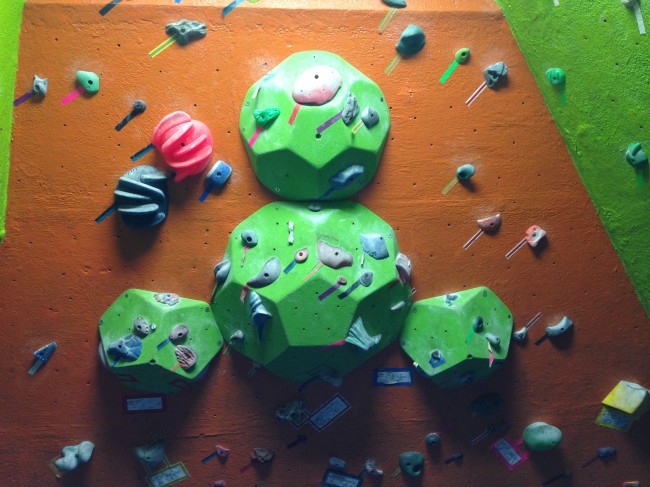
BIG HOLDS + PIGGY BACKS + VOLUMES
As the average size of climbing gyms has grown over the years, so too has the size of climbing holds — or maybe it’s the other way around, with gyms expanding bigger and bigger to keep up with the giant holds and volumes that are now available! Either way, shapers have introduced some gigantic shapes, like Pusher’s the Pond and the Boss and So iLL’s the Growth, that resized people’s expectations. Piggy back holds expanded routesetter’s toolbox, and then came the volumes — life size features that could be fastened to an existing wall and instantly change the wall’s climbing terrain.
HOLLOWBACKS
As holds became bigger and bigger, they also got heavier and heavier. All that polyurethane made them increasingly expensive and challenging to haul up the wall. With the introduction of the hollowback design, pioneered by ETCH and VooDoo, shapers could continue supersizing holds without breaking the bank or the back.
ICONIC OUTDOORS
As shaping improved we were introduced to some iconic designs that set the standard for bringing the best of the outdoors to the indoors. VooDoo perfected granite texture, eGrips brought us hueco patinas and Pusher introduced Fontainebleau to America with The Boss. Meanwhile, Franklin made entire holds sets mimicking famous outdoor problems that allowed you to recreate the essential moves inside.
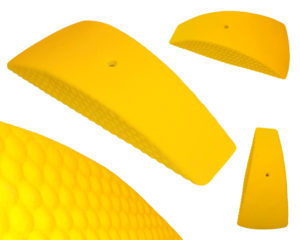
ICONIC INDOORS
While real rock remains the primary inspiration for most hold companies, a few have veered away from this trope to create some of the most original, and fun, shapes to hit the indoor arena. Ty Foose brought the now iconic Bubblewrap texture to eGrips and in the process crafted the first new non-organic texture to climbing, which has since been copied and spun off by countless other brands. VooDoo introduced dual-tex to climbing hold design, which allowed routesetters to force moves like never before.
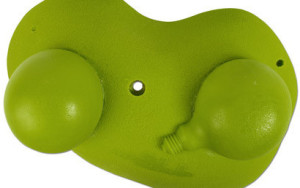
So iLL and Cryptochild took an even bigger step away from real rock design, upending what people thought a climbing hold could be. Why not a light bulb, a baby head or giant hands? In the other direction, Teknik mastered the aesthetic of simplicity with their line of beautiful clean shapes.
The color of climbing holds has also stepped away from real rock. While the first shapes all aimed for earth tones, over time hold companies experimented with brighter colors, swirls and layers. Today, bright neon colors are the norm, with monochromatic routesetting driving color selection more than aesthetics.
These innovations, and others, have presented indoor climbers with completely novel experiences and by doing so have widened the separation of indoor and outdoor climbing. These indoor-only designs are one important component in the evolution of indoor climbing into its own sport.
HOLD PRODUCTION
Many of the hold companies operating in America started as garage experiments, with lots of trial and error and with everything done by hand. As hold companies have grown and become more professional, their manufacturing has outgrown the days of buckets and stir sticks of polyurethane. In our next installment on the evolution of the climbing hold industry, we’ll be looking at the trend toward outsourcing hold production with professional manufacturing companies.

Climbing Business Journal is an independent news outlet dedicated to covering the indoor climbing industry. Here you will find the latest coverage of climbing industry news, gym developments, industry best practices, risk management, climbing competitions, youth coaching and routesetting. Have an article idea? CBJ loves to hear from readers like you!



